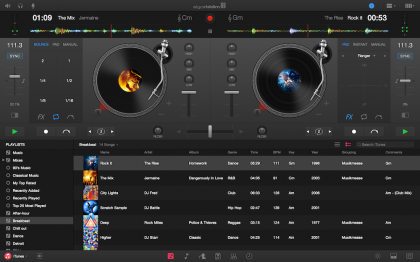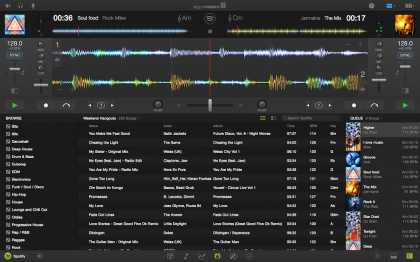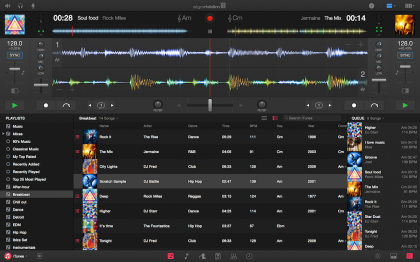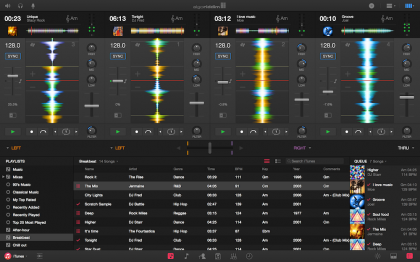January 9, 2015
Written by Dave Mark
Carlos Ribas is an indie developer. His app is called HoursTracker. HoursTracker went live in July, 2009 and has been a work in progress ever since.
The linked story lays out Carlos’ experience with the App Store from a financial perspective. He shares his revenue figures and his experience with iAds versus in-app purchase.
Bottom line, with a broad enough customer base, he makes more money with the App Store than he could with a full time job. And for many people, that’s the dream.
[Via MacStories]
Written by Dave Mark
The Guardian:
When the Charlie Hebdo website, which was down for much of the day, came back online it carried the phrase Je Suis Charlie in bold letters, with Charlie written in the font of the publication’s masthead. Viewers who clicked on the link below saw the same poster, repeated again and again in languages including Arabic, German and Spanish.
Apple ran the same message in a stark black and white banner at the bottom of the front page of their French language web site.
Written by Dave Mark
Follow the link to an interactive page listing a number of historic figures along with their daily regimen. It might sound dull, but it is fascinating, especially if you have an interest in history or design. The history part is obvious, but if you spend a few minutes hovering over different areas of the chart and reading, you’ll see a terrific interactive design at work.
The data is culled from the highly regarded book Daily Rituals by Mason Currey.
Take a minute to check it out. I found it well worth the time.
[Hat tip to ParisLemon]
January 8, 2015
Written by Jim Dalrymple
I really like Mayer, but I’m not sure she can turn things around quickly enough for the critics.
Written by Jim Dalrymple
U.S. District Judge William Alsup in San Francisco said the plaintiffs, Uriel Marcus and Benedict Verceles, failed to show that Apple made “affirmative misrepresentations,” despite citing online complaints and Apple marketing statements calling the laptops “state of the art” or the “most advanced” on the market.
People have to stop these bullshit lawsuits.
Written by Shawn King
CNET:
Smartphones are a top choice for today’s street criminals, especially teenagers. In the year ending in June 2013, nearly two-thirds of robberies by minors in San Francisco involved cell phones, according to the city’s public defender. Government officials have called the trend an epidemic. One in 10 smartphone owners in the United States have had their phone stolen. More than 3 million were pilfered in 2013, nearly double the number nabbed the year before.
A reminder to always be aware of your surroundings and how you use your iOS device, or any device for that matter, while out in public. I’m always intensely aware of how I use my iPhone, iPad and DSLR while out and about.
Written by Shawn King
Vancouver Sun:
Get your 99 cent apps while you can, iPhone and iPad users. Apple will soon hike the prices in its App Store for Canadian customers, according to an email sent to software developers.
The email, sent out on Wednesday, said the unspecified price increase in Canada, Norway and European Union countries would take effect within 36 hours.
Apple said foreign exchange rates were triggering the increase in Canada.
I wonder how it’s going to affect sales? The 99 cent price point is generally thought of as a no brainer but even a small increase in the price sensitive App Store can significantly lower sales.
Written by Shawn King
Tech in Asia:
Fresh research from UBS estimates Apple sold 69.3 million iPhones in the last quarter of 2014, setting an all-time record for the company. China accounts for more than a third of those shipments. A delayed release for the iPhone 6 and 6 Plus in China doesn’t seem to have put much of a dent in the devices’ sales figures, which don’t even account for grey market units brought in from Hong Kong and other countries.
As (easily) predicted by many. And it will only increase from here going forward. China is the new centre of Apple’s iPhone sales.
Apple on Thursday said it set a new record during the first week of January as customers purchased nearly half a billion dollars on apps and in-app purchases. What’s more, New Years Day 2015 was the single biggest day ever in App Store sales history.
This huge start for Apple’s 2015 came after a record-breaking 2014 in the App Store, the company said. Sales in 2014 rose 50 percent and apps generated over $10 billion in revenue for developers.
“This year is off to a tremendous start after a record-breaking year for the App Store and our developer community,” said Eddy Cue, Apple’s senior vice president of Internet Software and Services. “We’re so proud of the creativity and innovation developers bring to the apps they create for iOS users and that the developer community has now earned over $25 billion.”
These numbers are just astounding. If there’s anything that proves your platform is strong, it must be the quality of the apps developers are making, and the enthusiasm customers show in purchasing them. Today’s news show both are stronger than ever.
With the support of its customers, Apple donated $20 million (RED) over the holidays, bringing its total contribution to over $100 million to the Global Fund to fight AIDS.
Apple also noted that Apple Pay now represents about 90 percent of credit card purchase volume in the US. Apple Pay is one of the best features Apple has released in years. It’s one of those services that anyone can use, feeling safe and secure. I use it all the time.
Written by Shawn King
Apple:
Tim Cook: “We’re proud to create 1M+ US jobs in all 50 states and ring in another record-breaking year for developers globally.” iOS developers were paid at the average rate of $28 million/day in 2014. $25 billion dollars cumulative has been paid to developers.
Little bit of well deserved back patting from Apple.
Written by Shawn King
The Internet Archive:
The collection includes action, strategy, adventure and other unique genres of game and entertainment software. Through the use of the EM-DOSBOX in-browser emulator, these programs are bootable and playable.
I never had a computer that could play any of these games but I recognize many of the names as classics of the genre.
Written by Shawn King
Pacific Standard:
It’s no secret in the jewelry industry that retail demand for fine jewelry is slipping. As Forbes reports, the demand for gold jewelry has dropped 30 percent since last year, and continues to fall. Even diamond behemoth De Beers had to admit in their 2014 Insight Report that “retailers have faced pressures from a weak economic environment and strong competition from branded luxury goods and experiential categories, as well as the low-price models of e-commerce companies.” Simply put: There are better things to spend money on, often at better prices, than jewelry.
Interesting premise. While I’m sure there are many contributing factors, I wonder how much the “rise of the machine” has contributed to this decline.
Written by Dave Mark
Fast Company:
In the last 10 years, Lego has grown into nothing less than the Apple of toys: a profit-generating, design-driven miracle built around premium, intuitive, highly covetable hardware that fans can’t get enough of. Last year, fueled in part by The Lego Movie’s Pixar-size popularity, the privately held company briefly surged ahead of rival Mattel to become the biggest toy manufacturer in the world, reporting first-half profits of $273 million on revenue of $2.03 billion.
An interesting read. Three things I see that changed the arc of Lego’s fortunes: First, there was the Star Wars marketing deal that allowed Lego to create an incredibly popular series of Star Wars-themed kits.
Second, there was the move into video games with Lego Star Wars, Lego Harry Potter, Lego Batman, etc. These games also saw the emergence of Lego’s sense of humor.
Finally, all of these marketing deals came together (along with that tongue in cheek sense of humor) to create the “Everything is Awesome” Lego Movie.
Fans adore the brand. Just like Apple.
January 7, 2015
Written by Shawn King
Jim and Shawn talk about Apple’s 2014, Amplitube and guitars!
Sponsored by Audible (Visit the link to get a free audiobook of your choice and a free 30-day trial membership), Squarespace (Use code GUITARS for a free trial and 10% off), and Yosemite by Cocoa Conference (Visit the link to learn more about this conference for Apple enthusiasts, designers, and developers! Seating is limited so the sooner you get your tickets, the better).
Written by Jim Dalrymple
Sounds great, but…
You have to hate it when the first words of something you expect to be good end in “but.”
Written by Jim Dalrymple
Waterstones has admitted that sales of Amazon’s Kindle e-book reader had “disappeared” after seeing higher demand for physical books.
The UK’s largest book retailing chain, which teamed up with Amazon in 2012 to sell the Kindle in its stores, saw sales of physical books rise 5pc in December, at the expense of the popular e-reader.
Kindle sales had “disappeared to all intents and purposes”, Waterstones said.
I’ll be honest, I don’t know how to explain this shift in sales. While I think it’s good that people are buying physical books, I think it’s way too early to say that e-books are dead.
Written by Jim Dalrymple
With seventeen of the most amazing people in the Apple community—some developers, but most not—Yosemite is a conference for the Apple community. Our speakers are some of the best and most-loved writers, designers, philosophers, and developers working in the Apple ecosystem.
I’ll be speaking at CocoaConf’s Yosemite Conference this year. I’m really excited about the line-up of speakers and meeting the attendees. I hope to see you there!
Written by Shawn King
Fast Company:
Introduced with grand ambitions last summer, the Fire Phone is widely seen as a fiasco. Originally priced at $199 and intended as an iPhone competitor, it now sells for 99 cents, and Amazon has taken a $170 million write-down largely attributable to unsold Fire Phone inventory. Yet Bezos finally answers the question with the kind of reasoning that investors, customers, and pundits have come to expect from him: Amazon is going to pour more resources into its phone. Defending the Fire Phone as a “bold bet,” Bezos argues that it’s “going to take many iterations” and “some number of years” to get it right.
I don’t think the Fire Phone will be around in two years.
Written by Jim Dalrymple
Gruber summed up my feelings on the MacBook Air.
Written by Jim Dalrymple
Whatever, the reasons, my mind keeps going back to the number — approximately $20 billion dollars of iPhones — roughly 34 percent of Apple’s total sales for the three months ending December 31, 2014. It explains everything about the company, its priorities and why it is starting to show signs of wear and tear across its other product lines.
Om brings up a good point—Apple’s focus is, and has been, on the iPhone for quite a while. Let’s not forget the record Mac sales over that period of time, though. Perhaps it’s the halo effect, but the Mac is doing better than ever.
Update: Om’s original article stated $20 billion, but it’s actually $43 billion.
Written by Dave Mark
Marco Arment was the voice behind the Apple has lost the functional high ground blog post that has gone viral over the past few days.
With the benefit of hindsight, Marco updated his post with a link to What it’s like to be popular for a day:
You might think this is a dream come true for a blogger, but it’s horrible.
Instead, I looked back at what I wrote with regret, guilt, and embarrassment. The sensationalism was my fault — I started it with the headline and many poor word choices, which were overly harsh and extreme. I was being much nastier and more alarmist than I intended. I edited some words to be more fair and accurate, but it was too late. I can’t blame the opportunists for taking the bait that I hastily left for them.
Whether you agree with Marco’s post or not, there’s no doubt it started a lot of good conversation about the state of Apple software and, hopefully, it raised awareness within Apple of the growing perception that there are fit and finish issues.
I continue to feel the same love for Apple products. My sense is that the world came rushing to Apple’s door (when they had relegated Apple as a niche player for such a long time) and pushed them into a new role, that of a world leader. As the requirements, demand, and pipeline grew, Apple had to grow rapidly to fill this new role. A tough adjustment for anyone to make.
At the same time, Apple was in a brand new kind of horse race, with Android and Samsung. The kind of horse race that rewards quick reactions and short term thinking and brings about feature cram. Tough to resist. Feature cram places incredible stress on testing and QA, especially when the calendar drives the release schedule (as opposed to, “we’ll ship when it passes all its tests”).
When Steve Jobs came back to Apple, one of the first things he did was simplify the product line. Whatever his intent, this ended up reducing the demands on QA and testing, giving them more bandwidth to do their jobs right.
Not sure if simplifying is the right answer here, but I can only imagine that the best minds at Apple are working on this problem.
Written by Dave Mark
Apple updated their iOS adoption pie chart on Monday. iOS 8 adoption is at 68%, iOS 7 is at 29%, pre-iOS 7 at 4%. Obviously, these numbers include some slight rounding up.
Written by Dave Mark
Beautiful Pixels posted their annual look at the best user interface animations from apps and the web. My favorite, from Lush for iPhone, is below. So very delicious.
[Hat tip, iOS Dev Weekly]
Written by Dave Mark
Wall Street Journal:
In a complaint filed in Superior Court in San Mateo County, Calif., Monster said Beats “fraudulently acquired” the Beats by Dr. Dre line of headphones through a “sham transaction” with HTC, which agreed to purchase a 51% stake in Beats for $300 million in 2011.
This is a complex tale. You might start by reading this article from February 2013, which lays out the history of the Beats, Monster deal.
It starts with Noel and Kevin Lee, the father and son team behind Monster. To hear the story told, the Lees were astute when it came to music, speakers, and headphones, but were in way over their head when it came to negotiating with the team of lawyers at Interscope.
There can’t be two winners. Monster solidified an agreement that got Beats Electronics alive and shipping headphones, but not without gigantic forfeit: Jimmy and Dre’s side of Beats would retain permanent ownership of everything that Monster developed. Every headphone, every headband, every cup, every driver, every remote control—if there was a piece of metal or plastic associated with Beats By Dre, Noel and Kevin Lee surrendered it to Jimmy and Dre. Monster would also be entirely responsible for manufacturing the products—a hugely expensive corner of the deal—as well as distributing them. The heavy lifting.
Back to the Wall Street Journal article:
The complaint asserts that Beats repurchased 25.5% of its own shares from HTC less than a month after the deal closed, allowing Beats to end its relationship with Monster due to a change-of-ownership clause.
Noel Lee ultimately sold his Beats shares:
In September 2013, eight months before Apple agreed to buy Beats in May 2014, Mr. Lee sold his remaining shares. In the suit, Mr. Lee alleges he sold the shares after being misled by a board member that no “liquidity event” was on the horizon for the next year or two.
But Monster’s suit said Mr. Iovine and Apple Senior Vice President Eddy Cue later told a technology conference that the deal was several years in the making.
The question is, does Lee have a piece of paper or an email specifically stating no “liquidity event” was on the horizon, or is this his word against someone else’s? Like it or not, this sounds more like business hardball, where the best prepared team wins.
Note that Apple was not named in the suit.
Written by Dave Mark
NASA:
The largest NASA Hubble Space Telescope image ever assembled, this sweeping bird’s-eye view of a portion of the Andromeda galaxy (M31) is the sharpest large composite image ever taken of our galactic next-door neighbor. Though the galaxy is over 2 million light-years away, the Hubble Space Telescope is powerful enough to resolve individual stars in a 61,000-light-year-long stretch of the galaxy’s pancake-shaped disk. It’s like photographing a beach and resolving individual grains of sand. And there are lots of stars in this sweeping view — over 100 million, with some of them in thousands of star clusters seen embedded in the disk.
This ambitious photographic cartography of the Andromeda galaxy represents a new benchmark for precision studies of large spiral galaxies that dominate the universe’s population of over 100 billion galaxies. Never before have astronomers been able to see individual stars inside an external spiral galaxy over such a large contiguous area. Most of the stars in the universe live inside such majestic star cities, and this is the first data that reveal populations of stars in context to their home galaxy.
Two million light years is a huge distance, almost unfathomably far away. If you are traveling 186,000 miles per second, think how far you could go in a year (186,000 * 60 * 60 * 24 *365 miles), then multiply that by two million. Now imagine how you’d go about taking a picture of something that far away.
Here’s a link to the picture itself.
January 6, 2015
Written by Jim Dalrymple
Swiss watch makers like TAG Heuer, the biggest brand in luxury goods group LVMH’s watch portfolio, had until recently largely dismissed the threat of “smart” gadgets, but LVMH watch chief Jean-Claude Biver says he had changed his mind on the subject.
Not a big surprise.
Matt Richman’s thoughts on the news:
In order to have even a chance of being as feature-rich as Apple Watch, then, TAG’s smartwatch will have to pair with an Android phone. However, TAG wearers aren’t Android users. Rich people buy TAG watches, but rich people don’t buy Android phones.
I agree.
There are very few companies that continue to impress me, but Algoriddim has done it time and again. It’s not only the products, but the attitude in building those products to be great that wins me over.
Algoriddim is well-known for making djay for iPhone and iPad. It’s a DJ app that caught the attention of first-timers and professional DJs from around the world. Late last year, the company took the lessons it learned from building the mobile app and built a version for the Mac.

djay Pro for Mac is very similar in appearance to its iOS counterpart, but this is definitely a pro app. It includes 64-bit processing, multi-core track analysis, support for Retina and 5K displays, graphics rendering at 60 frames per second, and of course, incredible sound quality.
Algoriddim was able to avoid the main pitfall that plagues many companies when they bring a pro app to market—complexity. Far too often I see pro apps that are so convoluted that it makes you want to pull your hair out trying to figure out how they work. That’s not a good experience, whether it’s a pro app or not.

I spoke with Karim Morsy, CEO of Algoriddim, last month and he outlined his philosophy for building djay Pro for Mac.
“Pro doesn’t mean complex, it means flexible,” said Morsy.
Exactly right.

djay Pro for Mac is all about layers. Not necessarily layers of complexity, but rather layers of increasingly fine options. This is what makes the so app accessible.
As a user, you want an app that you can grow with as you become more experienced. You don’t want to feel like you’re being held back because you don’t have all the features needed to get the job done. Balancing that with not overwhelming people with too many features is tough, but Morsy and his team did it.

There are a lot of companies out there that could learn a lot about building pro apps from Algoriddim and their approach to djay Pro for Mac. At $49 on the Mac App Store, it’s underpriced for what you get.
Written by Jim Dalrymple
An 86-year-old woman wrote this to her bank manager. Priceless.
Written by Jim Dalrymple
Stephen Hackett has a look at a dozen RSS readers for OS X and while the winner is no surprise, it’s a great read.
Written by Shawn King
Huffington Post:
From the great ancient capitals to the modern cities of Asia, the Americas, and beyond, here are the 50 cities you must see during your lifetime.
Out of the 50, I really only want to visit 23 of the listed cities. I’ve been to 11 so far.




